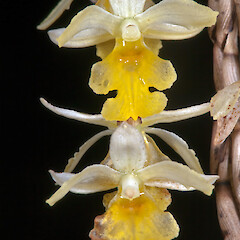Earina mucronata
Common name
bamboo orchid, peka-a-waka, spring earina
Synonyms
Earina quadrilobata Col.; Earina aestivalis Cheeseman
Family
Orchidaceae
Flora category
Vascular – Native
Endemic taxon
Yes
Endemic genus
No
Endemic family
No
Structural class
Orchids
NVS code
The National Vegetation Survey (NVS) Databank is a physical archive and electronic databank containing records of over 94,000 vegetation survey plots - including data from over 19,000 permanent plots. NVS maintains a standard set of species code abbreviations that correspond to standard scientific plant names from the Ngä Tipu o Aotearoa - New Zealand Plants database.
EARMUC
Chromosome number
2n = 40, 40(+0-2)
Current conservation status
The conservation status of all known New Zealand vascular plant taxa at the rank of species and below were reassessed in 2017 using the New Zealand Threat Classification System (NZTCS) – more information about this can be found on the NZTCS website. This report includes a statistical summary and brief notes on changes since 2012 and replaces all previous NZTCS lists for vascular plants.
Please note, threat classifications are often suggested by authors when publications fall between NZTCS assessment periods – an interim threat classification status has not been assessed by the NZTCS panel.
- Conservation status of New Zealand indigenous vascular plants, 2017 . 2018. Peter J. de Lange, Jeremy R. Rolfe, John W. Barkla, Shannel P. Courtney, Paul D. Champion, Leon R. Perrie, Sarah M. Beadel, Kerry A. Ford, Ilse Breitwieser, Ines Schönberger, Rowan Hindmarsh-Walls, Peter B. Heenan and Kate Ladley. Department of Conservation. Source: NZTCS and licensed by DOC for reuse under the Creative Commons Attribution 4.0 International licence.
2017 | Not Threatened
Previous conservation statuses
2012 | Not Threatened
2009 | Not Threatened
2004 | Not Threatened
Distribution
Endemic. New Zealand: North Island, South Island, Stewart Island/Rakiura, Chatham Islands.
Habitat
Coastal to montane. Mostly epiphytic on forest tree trunks and branches, sometimes on fallen logs, and found as a also rupestral on rocks, cliff faces or banks. Occasionally colonising brick or concrete walls within urban areas.
Detailed description
Epiphytic or rupestral, rhizomatous, perennial, producing numerous leafy, unbranched, long persistent, wiry, cane-like stems up to 1 m long. Rhizomes extensive, much intertwined and firmly attached to substrate, fleshy, more or less spongy, initially creamy white maturing buff-yellow. Leaf-sheaths imbricating, persistent, distichously arranged, 5–15 mm long, 2–3 mm diameter, not split, tubular, flattened, each overlapping with and covering the lower ⅓–½ of the leaf-sheath above, exposed surface ivory to pale whitish-yellow, maculate with small orbicular to ovate dark purple-black spots. Leaf-sheath junction with leaf lamina not flared. Leaves usually flexuose or slightly curled in upper ⅓; lamina short-lived, disarticulating at leaf-sheath junction, 1–3-nerved, 60–200 × 3–5 mm, green to dark green, linear-lanceolate, widest near base and tapering gradually to an acute, minutely acicular tip; midrib of upper lamina surface mostly weakly depressed, hardly prominent, lateral veins mostly inconspicuous. Inflorescence a racemose panicle. Panicle up to 100 mm long, mostly pendulous; racemes 2–12, usually well spaced on fine, slender, wiry axis, each 30–40 mm long; floral bracts c. 3.5–4.2 mm long, scarcely overlapping, prominently longitudinally ridged, completely covering the very short pedicels. Perianth 10–12 mm diameter, opening widely (flaring), pale, slightly greenish-cream to greenish yellow, or completely white. Sepals elliptic, subacute. Petals slightly broader and more obtuse. Labellum broader and very conspicuous, yellowish, yellow-orange, deep apricot or completely white, flaring widely at flowering, broadly oblong with broader proximal portion connect by a narrow waist-like neck to the almost equally broad distal lobe; base with two inconspicuous ridges leading down to a small pit-like nectary. Column shorter than labellum, narrow to base, wings absent or minute, pollinia long-oval. Capsules elliptic-ovoid, ovoid, deeply, longitudinally grooved, yellow green to green maturing grey.
Manaaki Whenua Online Interactive Key
Similar taxa
Earina aestivalis Cheeseman which is similar is distinguished by its usually more compact growth habit, and shorter (up to 600 mm long), fewer, wider (up to 8 mm long ) leaves. The leaf-sheath at the leaf junction is widely flaring and the leaves are deeply 3-nerved with the central midrib, broad, prominent and deeply channelled, and the lateral veins very conspicuous. The leaf sheath spotting is more obvious and the spots larger and darker. E. aestivalis tends to flowering later (December to March) otherwise the flowers are scarcely different.
Flowering
August–January
Flower colours
Orange, Yellow
Fruiting
September–April
Life cycle
Minute seeds are wind dispersed (Thorsen et al., 2009).
Propagation technique
Easily grown in a hanging basket in standard orchid mix. Often can be strapped to a tree trunk and provided it is kept moist during the drier months it grows readily. This species does best in semi-shade. The orange-green to yellow-orange flowers are produced in profusion and are especially attractive. Occasional white flowered forms also occur which are rather unusual. Should not be removed from the wild.
Etymology
earina: Springtime
mucronata: Short, sharp pointed
Where To Buy
Occasionally available from specialist native plant nurseries.
Attribution
Fact Sheet prepared for NZPCN by P.J. de Lange 14 April 2007. Description adapted from Moore and Edgar (1970).
References and further reading
Moore LB, Edgar E. 1970. Flora of New Zealand, Volume II. Indigenous Tracheophyta: Monocotyledones except Gramineae. Government Printer, Wellington, NZ. 354 p.
Thorsen MJ, Dickinson KJM, Seddon PJ. 2009. Seed dispersal systems in the New Zealand flora. Perspectives in Plant Ecology, Evolution and Systematics 11: 285–309. https://doi.org/10.1016/j.ppees.2009.06.001.
NZPCN Fact Sheet citation
Please cite as: de Lange, P.J. (Year at time of access): Earina mucronata Fact Sheet (content continuously updated). New Zealand Plant Conservation Network. https://www.nzpcn.org.nz/flora/species/earina-mucronata/ (Date website was queried)
















